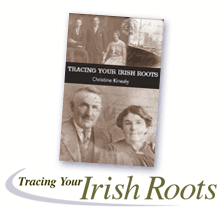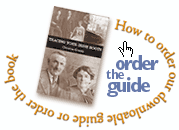 |
 | |||
 Christine Kinealy  Headings
In this section of Irelandseye's 'Ireland Genealogy' course, extracted from our exclusive downloadable PDF version of Tracing Your Irish Roots by Christine Kinealy, we concentrate on the importance of place. Places And Place NamesWhen trying to trace your ancestors in Ireland, it is important to have as precise an idea as possible about their place of origin. Occasionally, if you only know their county of origin, this may be sufficient to locate them but, in general, the more precise you can be about their address, the better.Townland, street or parish address are the most common - and most useful - means of identification. Surnames too, particularly unusual ones, can sometimes provide a clue to a family's place of origin. If you know, for example, that your grandfather, Desmond Quiery, lived in the townland of Drumbrughas in 1890, it is useful to find out as much about that area as possible. To do this, consult The Alphabetical Index to the Townlands and Towns of Ireland, which is available in any good reference library. From it you will see that Drumbrughas is a townland in Carly, Fermanagh, in the barony of Clanawley, the parish of Killesher, the county district of Enniskillen and the district electoral division of Drumane. Its size is 216 acres, 15 perches and its reference number for Ordnance Survey Maps is 33. Write this down, as this information will prove very helpful later in your search.
The address is a basic unit of identity but it can take a variety of forms. It is therefore invaluable to familiarise yourself with the different locations used. Different records are categorised by various Provinces: there were originally five of these but there are only four in modern Ireland - Ulster in the north; Leinster in the east; Munster in the south, and Connaught in the west. The province is the largest geographic division in Ireland. Counties: the system of `shiring' Ireland commenced in the twelfth century as English influence spread throughout Ireland. Ulster was the last part of the country to be shired and was divided into counties Coleraine, Tyrone, Fermanagh, Cavan, Monaghan, Armagh, Antrim, Down and Donegal. County Coleraine was subsequently renamed County Londonderry. Only six of these Ulster counties form Northern Ireland - the remaining three are in the Republic of Ireland. Baronies: baronies are subdivisions of counties. As an administrative unit they have been obsolete for about a century, but between 1600-1900 they were frequently used as a unit by the government for carrying out surveys. Parishes: since the religious Reformation of the sixteenth century, there have been two separate parish structures in Ireland; civil and Roman Catholic. The term `civil parish' refers to the parish of the Established Church in Ireland - that is, the Church of Ireland. This Church remained the state Church until 1869. Townlands: you will frequently come across this term in your research. A townland is the smallest administrative unit in Ireland. It does not relate to a town. There are about 64,000 townlands in Ireland. Traditionally, in rural areas, people identified closely with their townland and it is therefore the basic form of address provided in many records. A valuable record of townlands exists in the Ordnance Survey Townland Maps (scale: 6 inches to 1 mile). County Districts Areas: these have a separate council and date from the late nineteenth century. District Electoral Divisions: these consist of a group of townlands clustered together. Ward Administrative Division: these exist within a city or large town. An address, therefore, is a unit of identity, which will help you to identify your ancestor and obtain further information about him or her. However, the address given on a document can take a variety of forms, and if you are aware of this, it will make your search more rewarding as it will allow you to use a wide variety of records to their best advantage. > > > Read the next page of this article
Tracing Your Irish Roots by Christine Kinealy, the essential and authoritative guide to discovering Irish ancestors is available from bookstores everywhere.
|
All Material © 1999-2008 Irelandseye.com and contributors

